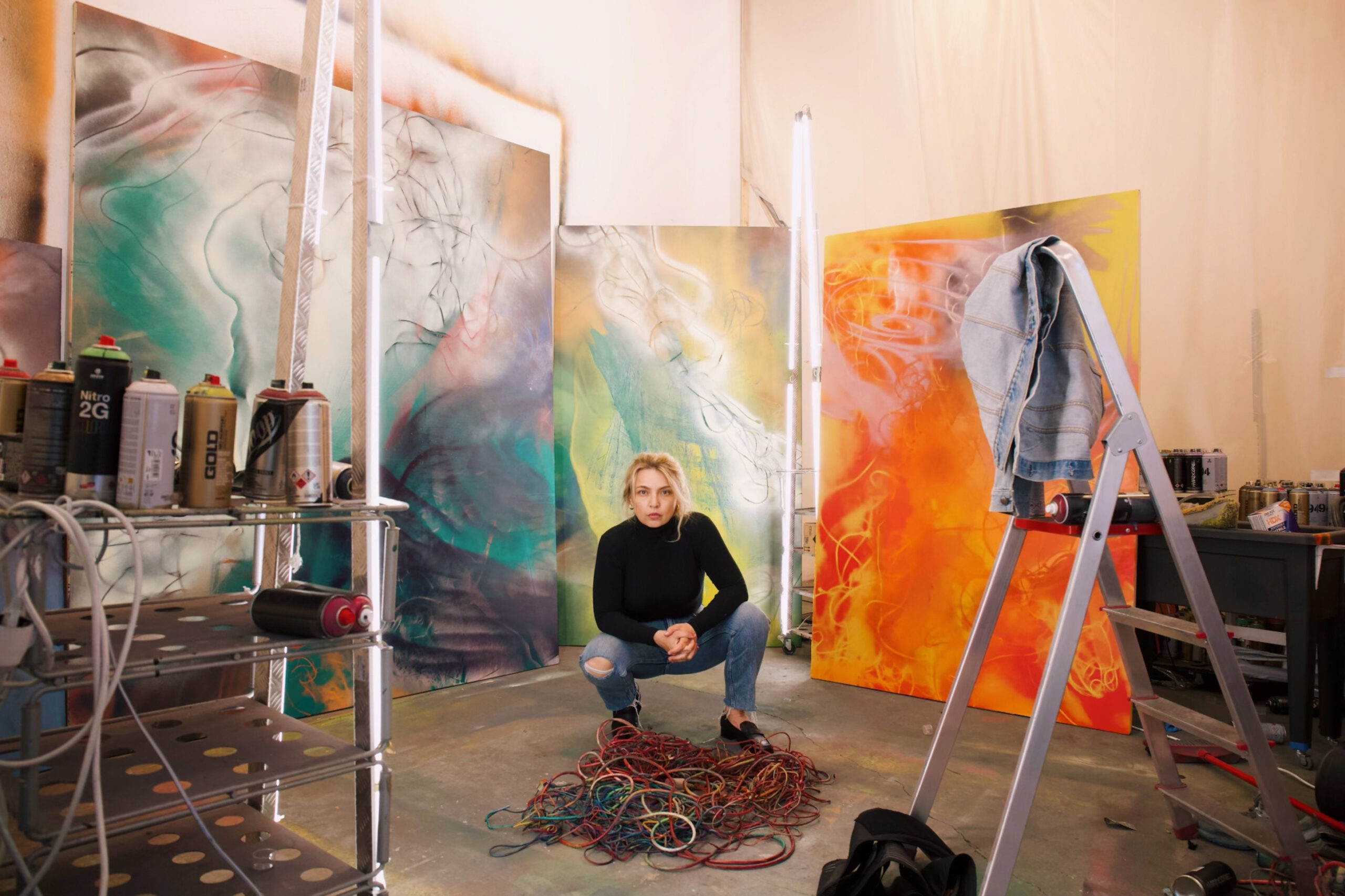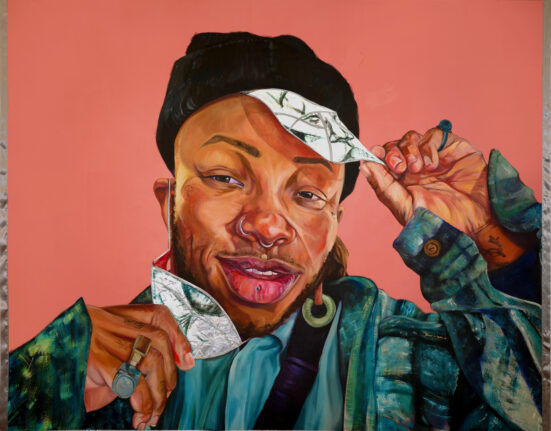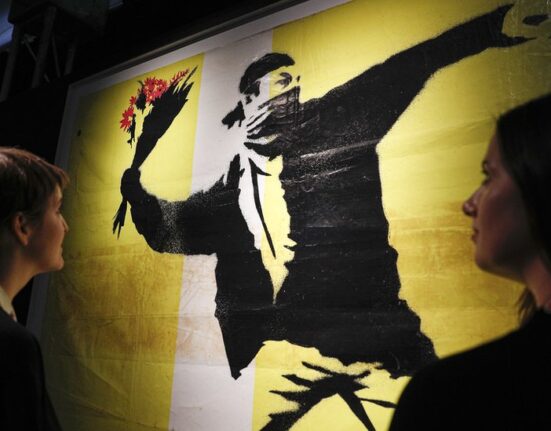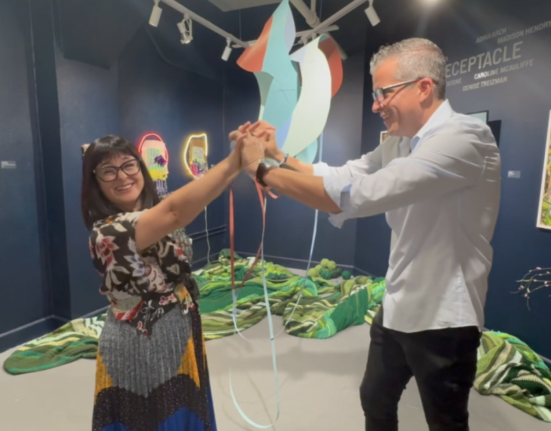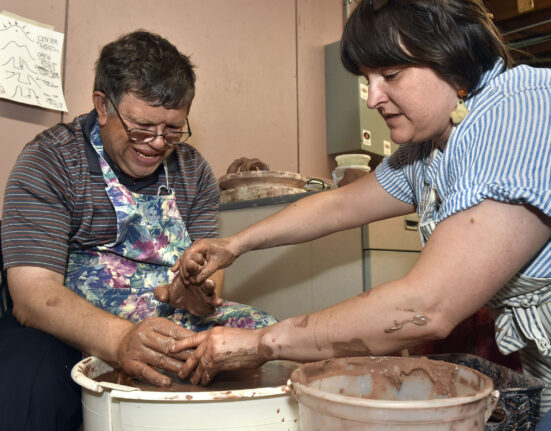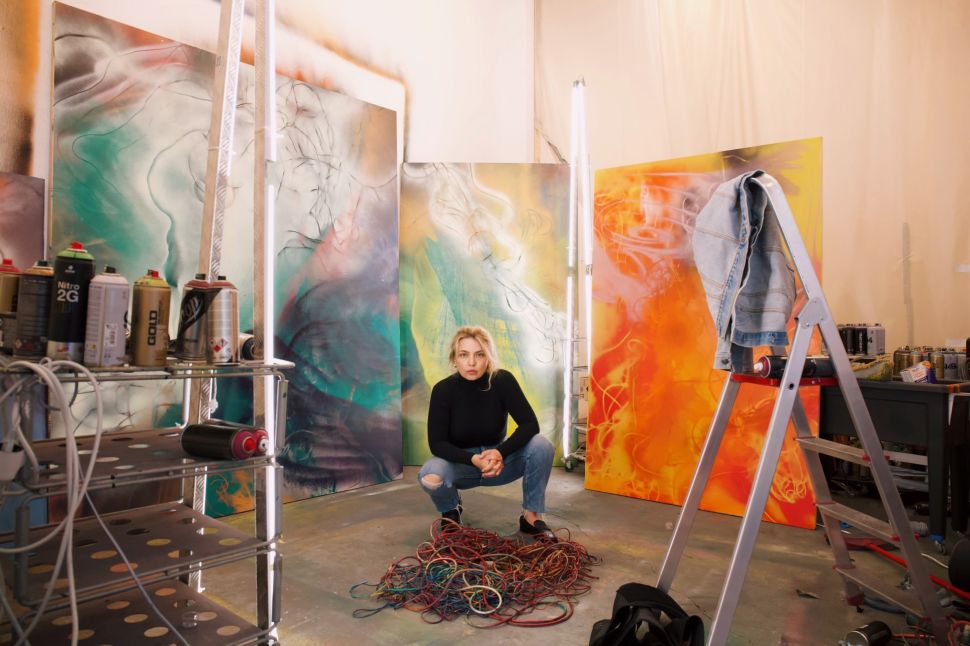
Originally from Phoenix, Arizona, American abstract artist Andrea Maria Breiling grew up surrounded by landscapes characterized by vivid colors, stark textural contrasts and vibrant hues of red, orange and pink activated by the sun. The atmosphere of the Mediterranean is very different but no less intense: it can trap you in a vortex of chromatic sensations that change over the course of a single day, depending on the position of the sun, while the sea breeze takes you on a sensory and emotional journey that reconnects with something ancestral. It’s what Breiling experienced during a four-month residency in Mallorca, Spain, during which she captured the very essence of the island and then translated it into a new series of vibrant abstractions now on view at CCA Andratx in Mallorca through September 22. We caught up with the artist one month after the opening of “There’s an Ocean Here, but You Are All I See,” her first institutional solo show, to ask about how the island inspired her and what she plans to do next.
You spent four months immersing yourself in the landscapes, colors and textures of Mallorca, which led to these vibrant abstractions. We know powerful natural sceneries can deeply influence a painter’s palette—it happened to Van Gogh, Monet and Renoir in the South of France. How do you see the island and its nature having changed or nourished your palette?
In retrospect, the time flew by. It’s July now, and Mallorca is a completely different island than it was when we first arrived in late February. Then, it was quite cold and brisk. The entire island was really cool, calm and quiet, but now it’s buzzing with so much kinetic energy, masses of people and crazy heat. The Mediterranean terrain immediately transformed my relationship with my visual aesthetic. The overall color of the island is so soft and subtle, with muted beiges, tans of sandstone rock formations and desert-like terrain. I noticed myself immediately shying away from vibrant colors in almost every aspect of my life here: everything from the shades of clothes I was wearing in the studio to the color palettes I chose for my works; it seems like it all shifted.
At the same time, whenever I did paint with vibrant colors, I felt a sense of representation with each color: yellows were the brightness of the rising and setting sun; the greens began to represent the turquoise shades of the Mallorcan water (the clear blue-green ocean water here is truly unlike any water I’ve ever seen before); reds and oranges reminded me of the local Spanish sandstone architecture: and lastly, when I picked out magentas and purples, I began to see the natural wildflowers that dot the beautiful rugged landscape.


The exhibition is divided into rooms representing distinctive elements, themes and color palettes related to the island that has inspired you. We have “The Sunroom,” “The Sunset,” “The Water” and “The Highland Highlights.” Did any of those influence you more than the others?
I think they all really needed each other. Each room is stronger when they’re part of the larger ecosystem. It’s a cohesive exhibition, not just a bunch of paintings, which is so important to me and my love of telling stories. The individual paintings have their own identities, sure, but I really see them as characters on a stage in my very own play.
My story of Mallorca would have been incomplete without all these elements: the brilliant sunroom, the earth tones in the sunset room, the cool blue-green water room and finally, the vibrant wildflower room. I wanted the show to hit the viewers in a poetic way, much like watching contemporary dance. I wanted the viewer’s body to feel the rhythm of the island as they walked through each element. Ultimately, my answer is no: no single element was more integral than the next. Rather, they were all equally inspiring and dependent upon each other.
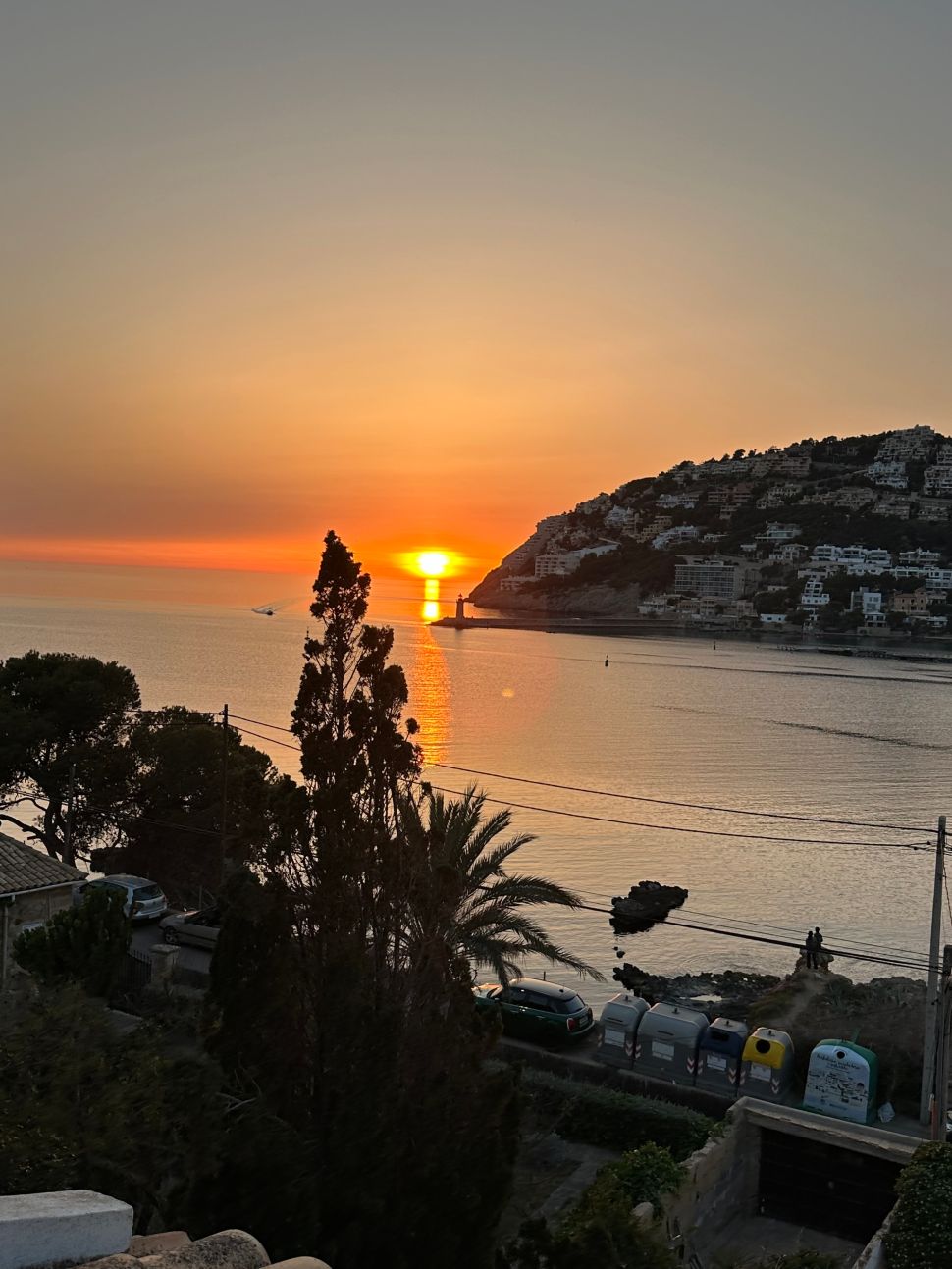

The title of the show is very poetic and evocative, emphasizing the relationship between the works and the island’s nature. Can you tell us more about what inspired it?
A huge aspect of my work is the sheer amount of energy I need to make a painting. For me, the act of painting is a very athletic sport, and it takes a lot of strength and power physically to make my paintings. Given those rigorous and taxing demands, over time, I have created systems to inspire, motivate and keep my energy up for the task. As you can imagine, the immersive nature of my months-long residency in Mallorca itself served as inescapable day-to-day inspiration… the climate, the scenery, the language, the food and the people all influenced and shaped my perception and approach to this body of work.
At a more tangible level, when I’m actually in the studio doing the work, one of the most important sources of inspiration for me is music. Having music in my studio while I work is one of the most important aspects of my creative process, providing motivation and inspiration and keeping me centered and focused to finish it all. The music isn’t just background noise, though. I’m an active listener who pays attention to lyrics. It’s not uncommon for me to write down words or phrases from songs when they feel like they fit the mood or the subject of the work as I’m making it. Later, when I’m naming pieces, I’ll often look at my notes on my iPhone and almost without fail, each word or phrase brings me right back into that moment in time, and I will remember exactly where and when I was in the studio: whether the sun was setting or rising or what was weighing heavy on my mind at that specific time. Many titles of my paintings are song lyrics or titles of songs, and they serve as time capsules of memories from my experience here. The same is true for everything I’ve ever made, so it’s almost like they’re poems memorializing my time here on earth… my human experience.
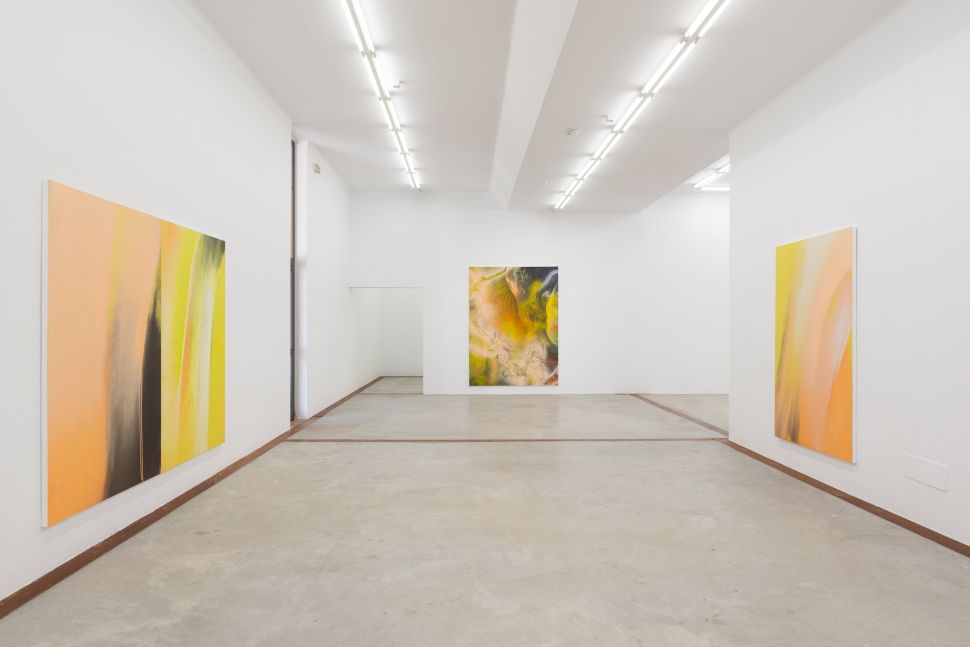

There’s indeed a rhythm that brings these paintings to life, accompanied by a well-calibrated musicality that shifts between moments of deep suspension and other peaks and climaxes, much like in a musical composition. What kind of music were you listening to while making those works?
During this residency, I had the group London Grammar on repeat, and a lyric from one of their songs wound up becoming the title of the exhibition here at the CCA. Overall, I love all kinds of music: everything from dark, deep, depressing shoegaze bands to upbeat techno, and even some pop country finds its way onto my studio playlist! I love the variety, and it’s all really dependent on my mood and what types of feelings and emotions I’m trying to soothe or conjure up! Music is so powerful; it’s crazy what it can do, isn’t it? When I’m in the studio, and I can tell that I’m really in the groove and the painting is going well, I will often start replaying one particular song on repeat… and this can go on for hours at a time, at any time of day or night! Luckily, I had very tolerant and understanding neighbors in Mallorca, as I rarely use headphones.
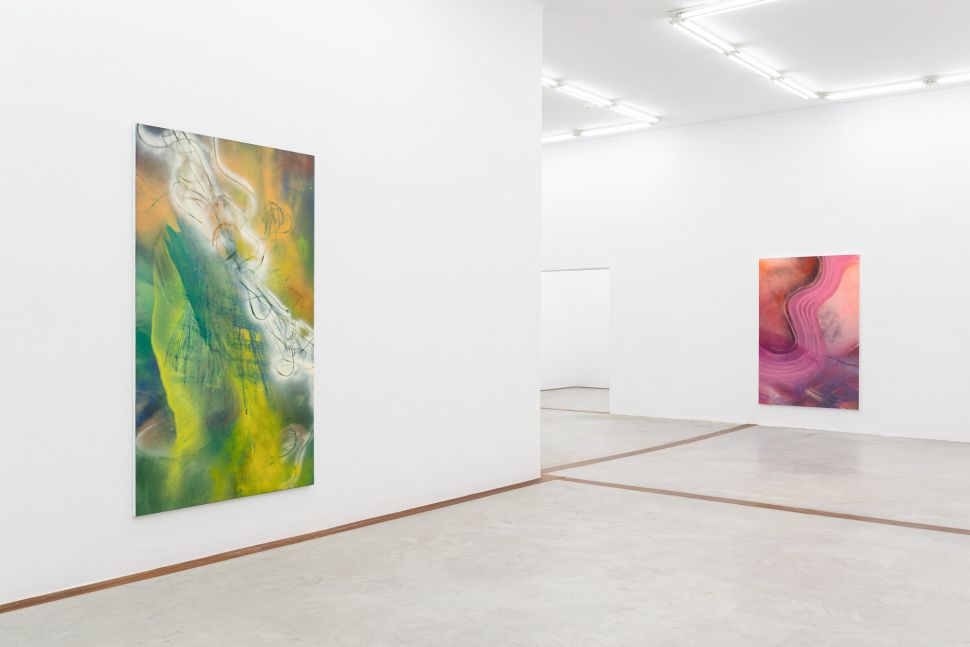

There are several approaches to abstraction, but the two main ones are “expressionist abstraction” and “spiritual abstraction.” I feel that your canvases are characterized by a combination of the two: we can see the body’s involvement in the dynamic swaths of colors, swirling fluid pictorial movements and explosive splashes. At the same time, there’s a mysterious depth, as with diving into the sea or the abysses of the subconscious. How would you describe your approach to abstraction?
My approach is, first and foremost, physical. Painting is a physical form of transcendence for me. Through the strain and through the physicality, a spiritual transcendence is possible, and it’s this sensation that brings me back. However, the poetics of transcribing my human experience in pictures, pictures that people want to engage with, is a conceptual experience that makes me long for a part in the historical conversation. I want to make pictures that contribute to the history of painting. It’s very important to me that this act is nurtured much like a science. In other words, how can I contribute? What can I do that will help move it along? How can my work inspire others? Right now, I’m in the exploration stage again, shifting from gesture and paint brushes into figuring out how to dye canvas and joining the conversation of color field abstraction (one of the last large important moments in abstraction, in my opinion).


Have you always been an abstract painter? What was your journey to achieve your style and formulate a distinctive visual universe?
It evolved over time. I started as a very open media artist: installations, video and even performance art. But I was narrowing in on painting toward the end of my undergraduate studies. My first exhibition after grad school was a gestural show where I used traditional brushes. While that show was running, something wasn’t sitting right with me. I didn’t like how my paintings were being discussed in terms of AbEx and the machismo of DeKooning and Pollock. I wondered how, or even if, I could align myself more with color field champions such as Helen Frankenthaer, Morris Louis and Rothko. I started studying them and learning what I would need to do to make this possible. The first step was to remove the brush! I had a real “light bulb moment,” and I felt so energized and excited at the possibilities.
At that point, I took some time off from showing and did a couple of residencies: one in Mexico City and another in upstate New York. I spent that time rigorously trying to stain the canvas and experimenting with just about any technique that might allow me to remove the paintbrush, but it really was not working. The staining just wasn’t achieving the vibrancy or the presence I was yearning for. It wasn’t until later when I returned to my L.A. studio and a studio mate of mine happened to leave a discarded box of spray paint at my door that I started to engage with this material in a serious way. I dedicated myself to mastering the techniques of spray paint application on stretched canvas until I could really make it my own and ultimately replace the paintbrush, just like I had been yearning to do for all those years. I haven’t looked back!


Your previous works reflected a blend of emotional intensity and movement, often characterized by frenetic, high-depth atmospheric style. In these new works, there’s a different depth and lyricism, a two-dimensionality that embraces the simplicity of color field painting while similarly drawing viewers into an immersive experience of abstraction. The Mallorcan natural beauty seems to have helped you “let go” of some of the more stylistic flourishes in your work so color and surface could tell the story…
Yes, definitely. The island was just so peaceful and subtle in its beauty that it naturally made me stand back and let the paint be paint and color be color. At some point, you just let go, as you said, and the work comes on its own. It wound up resulting in paintings that were even more color field in nature than I could have hoped for at the outset.
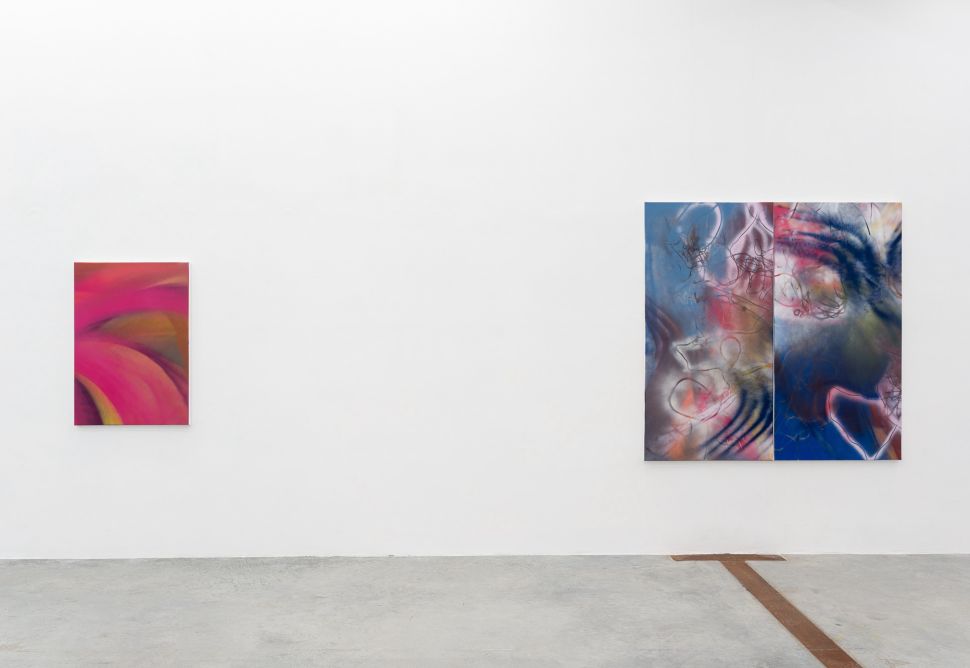

Where would you like to do your next residency? Is there a particular location you feel would nourish your work?
That’s such a dreamy question! So many bucket list places come to mind… but I guess I would say Ireland. My partner is Irish; he would be in heaven, and I would love that. But we both love the ocean, so I’d also be thrilled with a residency just about anywhere as long as it’s close to water. Traveling and experiencing the world while being able to paint my experiences is really the most insane and rewarding thing I can imagine doing, and I feel so grateful each and every time it happens.
“There’s an Ocean Here, but You Are All I See” will run until the end of September. What’s next for you this year?
A much-needed siesta! But honestly, I need to get home and regroup a little bit. There have been talks about doing a show at Night Gallery in Los Angeles in the spring of 2025, but we will see. Ideally I’d love to take a bit of a break and just make some work without any hard deadlines or commitments and perhaps experiment with some other mediums. I’ve always been curious about trying my hand at sculpture. I’ve always dreamed of doing bronzes but who knows what the future might hold. I’ve made a lot of paintings this year, so it feels like it might be an opportune time to dive into something new. Stay tuned! Who knows what might be on the horizon… the only thing that’s certain is that whatever comes next will have to wait until after that siesta.

